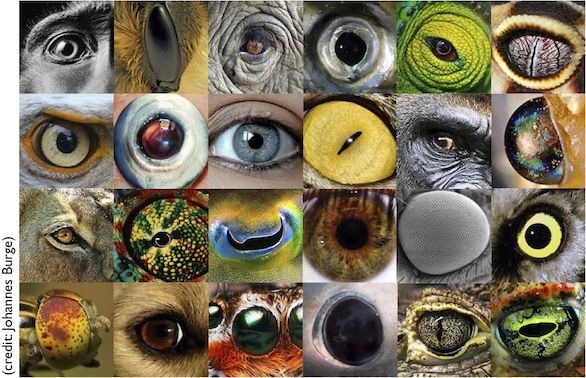
Human Vision and Animal Vision: A Comparative Exploration
Vision is one of the most important senses, enabling organisms to navigate, find food, avoid danger, and communicate. In humans, the eyes are highly specialized organs designed for detailed, color-rich perception. In contrast, animal vision is incredibly diverse; different species have evolved visual systems tailored to their specific ecological niches. By comparing human vision to that of various animals, we gain insights into the evolutionary pressures that have shaped sensory systems across the animal kingdom.
Human Vision: Precision and Color
Humans possess a pair of forward-facing eyes that provide binocular vision, giving us excellent depth perception. The retina of the human eye contains two main types of photoreceptors: cones and rods. Cones enable color vision and are concentrated in the fovea—a small area of the retina that provides high-acuity central vision. Humans are typically trichromatic, meaning we have three types of cones sensitive to red, green, and blue wavelengths. This configuration allows for the perception of a wide range of colors and fine visual details.
Moreover, the human visual system is well adapted for daylight conditions, providing high-resolution images under bright light. However, in low-light situations, our vision becomes less acute due to the lower density of rods in the foveal region. These adaptations reflect the human reliance on detailed vision for tasks such as reading, recognizing faces, and navigating complex environments.
Animal Vision: Diversity in Design
Animals, by contrast, exhibit an astonishing variety of visual systems, often diverging markedly from the human model:
1. Color Perception:
Many mammals, like dogs and cats, are dichromatic—they possess only two types of color receptors, which limits their color discrimination compared to human trichromacy. On the other hand, many birds, reptiles, and some fish are tetrachromatic or even pentachromatic, meaning they have four or five types of cones. This extra set of photoreceptors enables them to see ultraviolet light and a broader color spectrum, aiding in tasks such as finding mates, identifying food, or spotting predators.
2. Visual Field and Resolution:
While humans have a narrow field of high-resolution vision concentrated in the fovea, some animals have evolved eyes that maximize their peripheral vision. For example, prey animals like rabbits and horses have laterally placed eyes, which give them a wide field of view to better detect approaching predators. In contrast, predators often have forward-facing eyes that allow for precise depth perception and tracking of moving prey.
3. Specialized Adaptations:
Certain species have developed extraordinary visual adaptations. The mantis shrimp, for instance, possesses one of the most complex visual systems known, with up to 16 different photoreceptor types. This allows it to detect polarized light and multispectral images far beyond human capability. Insects like dragonflies have compound eyes composed of thousands of individual units, providing rapid motion detection essential for catching prey in midair, though at the cost of lower spatial resolution.
Comparative Insights
Comparing human vision to animal vision highlights both similarities and striking differences. Humans excel in tasks that require detailed, color-rich perception in well-lit environments, thanks to our specialized foveal vision and trichromatic color system. Animals, however, display a wide array of visual adaptations that optimize their perception for specific ecological needs—whether that is a broader field of view, enhanced sensitivity in low light, or the ability to perceive wavelengths outside the human visible spectrum.
These differences underscore the principle of evolutionary adaptation: the visual system of each species reflects the demands of its environment. While humans evolved for precise, high-acuity vision to support complex social and cognitive tasks, many animals have honed their vision to survive as either predators or prey in diverse habitats.
Conclusion
The study of vision—both human and animal—reveals a rich tapestry of evolutionary solutions to the challenges of perceiving the world. Human vision is uniquely optimized for detailed color discrimination and depth perception, supporting our complex cognitive and social lives. In contrast, animal vision showcases an incredible variety of adaptations, from ultraviolet sensitivity in birds to the rapid motion detection of insect compound eyes. Together, these systems illustrate the myriad ways life on Earth has evolved to interpret light, offering valuable insights into both the commonalities and diversity of sensory experience.
Works Cited
American Academy of Ophthalmology. “Vision Basics.” American Academy of Ophthalmology, https://www.aao.org/eye-health/tips-prevention/vision-basics. Accessed 9 Feb. 2025.
National Eye Institute. “Healthy Vision.” National Eye Institute, U.S. Department of Health and Human Services, https://www.nei.nih.gov/learn-about-eye-health/healthy-vision. Accessed 22 Jan. 2025.
National Geographic. “Animal Vision.” National Geographic, https://www.nationalgeographic.com/animals/article/animals-vision. Accessed 25 Jan. 2025.
Smithsonian Magazine. “The Incredible Diversity of Animal Vision.” Smithsonian Magazine, https://www.smithsonianmag.com/science-nature/the-incredible-diversity-of-animal-vision-69788750/. Accessed 2 Feb. 2025.
Post a comment